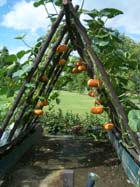Artificial lighting for Hydroponic Plants
Metal Halide Bulbs Many gardeners recommend metal halide grow lights above all others. The reason being it's excellent spectral distribution. Metal halide bulbs emulate bright summer sunlight and contain all the energy peaks at wavelengths of the visible spectrum. To plants this means quality simulated sunlight and photosynthesis at a level much higher than that which fluorescent lamps can achieve.
Also, metal halide grow lights have good lumen maintenance and long life expectancy. Having good lumen maintenance means that as a lamp ages, its decline in lumen output is very gradual. After 12 months of use at 18 hours per day, a 1000 watt metal halide lamp should be replaced as it is only about 85% as bright as the day you bought it. Halide is the best bulb technology available for achieving the highest level of plant and flower growth. They allow the flexibility of multi-crop, multi-season indoor gardening.
High Pressure Sodium Bulbs (HPS) growlights are the only growlights comparable to metal halide bulbs. They have good spectral distribution, but sodium lights cannot compare to halide in the blue end of the spectrum. Just in the same way, Metal Halide lights can’t compete with Sodiums in the red end of the spectrum.
Sodium grow lights are particularly high in the yellow and red regions of the spectrum. This is the type of light fruiting and flowering plants like best. Because of the focus on red light, some varieties of plants grown with sodium lights alone can become elongated and leggy.
Sodium grow lights do, on the other hand, stimulate flower and fruit production more efficiently than metal halide bulbs, making them an important light source best used in conjunction with metal halide either in addition to, or cycled together. High Pressure Sodium bulbs also have a much longer life expectancy than metal halides, lasting up to two (2) years!
LED Grow Lights Plants seem respond to LED lights similar to T5 fluorescent fixtures. They result in tight inter-nodal growth, and short stocky, strong plants. The plants do look a little different - the leafs tend to curl down. But the leaves are thicker and a more healthy shade of green. Vegetative growth is a little slower compared to a 400 watt HPS light but are healthy and progress normally.
Fruiting and flowering is also slightly slower but healthy and strong, with surprisingly dense development. LED's are NOT the best choice for really big plants, or anyone that wants a seriously productive garden, but for a nice hobby garden (or heat-free summer garden), they work really well.
High Output Fluorescents T5 high output fluorescent tubes produce very little heat which lets you position them closer to your plants to raise the light levels. T5 high output fluorescents are great for seedlings and cloning! T5 high output fluorescents put out 5000 lumens per tube and have solid state electronic ballasts that do not emit heat, noise or vibration.
Compact Fluorescent lights (CFL's) work best in small spaces as they do not produce much heat or use much electricity. For fruiting or flowering plants, the 2700K warm bulb is best. For plants taller than a foot, regular fluorescent tubes can be supplemented on the plant sides. (Note: When using CFL's you should remember to use the actual wattage NOT their wattage equivalents when calculating how many watts you need for your hydroponic system.)



